This device is attached to the limb with straps and buckles. Fit varies in design and size, so choosing the right brace is important. The orthosis can be attached independently.
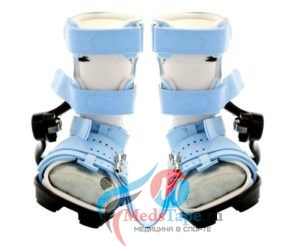
- Choosing a knee brace - what you need to know
- layout
- How to choose the size of the orthosis?
- Orthotic recommendations
- Therapeutic knee brace
- purpose and application
- Functional
- rehabilitation
- Patellofemoral orthosis
- preventive measures
- types of orthotics
- Special features of the knee brace
- Care
- What is an orthosis?
- Welcome to SPb! SHOP
- knee braces
- Indications for use.
- types of orthotics
- When professional athletes should wear orthoses
- For the ankle
- For the knee joints
- How to choose the right knee brace
- cost of the orthoses
- Application
Choosing a knee brace - what you need to know
An orthosis is a complex type of orthosis with 3 different degrees of stiffness and 4 different types. It is used for treatment, rehabilitation and protection of the knee joints. Popular manufacturers: OPPO, MEDI, ORLETT, DONJOY, OTTO BOCK, ORTO, ÖSSUR, FOX, EVS. The cost ranges from 5,000 to 95,000 rubles.
Medicine and industry have made significant advances in managing musculoskeletal disorders. Knee injuries and diseases are among the most common. The Knee Brace is a knee brace that has been proven to solve such problems.
layout
The knee brace is an orthosis that differs from others in many ways. Structurally, it is a split orthosis made of soft and rigid nonwovens (neoprene, plastics, carbon, metals, alloys). Design and manufacture are based on practical experience, modern medical advances, high-tech materials and innovative solutions. Many knee problems that used to be difficult to solve can now be successfully tackled.
- Elastic cuffs (ensure bilateral immobilization of the joint);
- polycentric locks (coordinate device and joint movement and have a sectorized range of motion from 0° to 150°);
- Stoppers (to restrict movement or fixation)
- Straps (to attach to the leg)
- Snaps (to adjust the device to the size and individual parameters of the person).
The construction can be rigid, semi-rigid or soft and can be adjusted to allow a certain range of motion up to complete immobilization (as a body orthosis).
The height of the orthosis can vary: standard (covers at least the lower third of the thigh and the upper third of the lower leg) or short (optimal for athletes).
The manufacturers offer a specific range of sizes for children and adults, with the right-sized models sitting perfectly on the leg. Depending on the version, the models can be male or female, designed for the left or right foot.
In special cases it makes sense to order a suitable orthosis according to individual parameters and needs.
How to choose the size of the orthosis?
An orthosis is a shoe or sandal connected to a special plate. Before choosing the right size orthosis, measure the length of the child's foot. To do this, place your foot on a piece of paper, trace its contours and measure the distance from the big toe to the highest point of the heel. Add 1 cm to this number. That is the size of the orthosis.
However, do not forget that clubfoot often has its own characteristics. For example, a big toe that sticks out or tilts to the side, a pronounced buckling point in the ankle, a narrow toe with a wide sole area. It is important not to forget these aspects when measuring.
Orthotic recommendations
Children's feet have sensitive skin that is easily irritated and prone to abrasions. It is therefore important to wear orthotic shoes carefully at first.
The following recommendations should be observed:
- A zinc ointment applied immediately before putting on shoes will help prevent irritation.
- In the first few days, the child will feel discomfort and will not get used to wearing the orthosis. Parents should try to distract the child or make shoe-wearing a game.
- The pole can damage furniture and the floor. To prevent this, just wrap them in a soft material.
- In most cases, the child initially feels a slight reddening of the skin. To reduce this, no alcohol-based solutions should be used.
- It is best to wear a thin sock made of soft cotton material under the orthosis. Thick socks with patterns should not be used. These consist of thick threads that put pressure on the skin under the belt.
- The straps should not be removed for sleeping. To make the child feel calmer, you can put his legs in a sleeping bag.
- The car seat and high chair must match the size of the harness. Otherwise the child will not fit in.
Wearing an orthosis allows you to definitively correct the correct position of the foot after the cast. It is especially important to follow the shoe regime recommended by the podiatrist.
Similar entries:
Unfortunately, no similar entries were found.
Therapeutic knee brace
Knee orthosis with lateral fixation - indications for use:
- joint instability, habitual dislocation;
- meniscus injuries, cruciate ligament sprains and cruciate ligament tears;
- Early phase of immobilization after fractures and dislocations;
- the postoperative period.
In children and adults, a band orthosis with articulated lateral limitations is also recommended for valgus or varus knee deformities that occur with X- and O-shaped curvatures of the lower limbs.

Applying a knee orthosis with lateral limitation
Below you will find brief instructions on how to put on the orthosis correctly:
- Before putting on the orthosis, set the flexion/extension angle specified by the doctor at the stop.
- When you put the orthosis on the leg, first adjust the height of the lateral retaining pins. Make sure that the restricting linkage mechanism is centered exactly on the outside of the linkage.
- Starting at the knee, first up the thigh and then down the shin, alternately adjust the straps and straps so that the orthosis does not hang down the leg but fits snugly.
Do not pull the orthosis too tightly on the leg when putting it on. Impaired blood circulation impairs the regeneration processes and in some cases can trigger the onset of necrosis.
side note. Unfortunately, this type of orthopedic device should not be worn by people with dermatological problems and/or venous lesions in the lower limbs.
Incidentally, a knee orthosis with lateral fixation relieves the knee joint so effectively that it is also suitable for patients with chronic diseases of the knee joint, e.g. B. Degenerative joint disease of the knee III.
purpose and application
An orthosis can offer fixation, protection, pressure relief and compensation, often more than one function can be combined - and is successfully used in the
- Treatment of complex knee injuries and trauma;
- rehabilitation after operations, sprains and dislocations;
- Correction of the knee joint in stiffening;
- a number of diseases: hemarthrosis, deforming arthrosis, osteochondropathy;
- Processes requiring knee immobilization and load reduction;
- Protection during sports activities.
The device is attached to the upper and lower leg and ensures the correct anatomical position of the knee joint, for pressure relief and movement control.
Different situations call for different types of braces, and these devices are divided into several types based on their purpose.
Functional
The goal is to support and protect the injured or bruised knee.
rehabilitation
By restricting unwanted movements, a rehabilitation orthosis speeds up the rehabilitation period after an illness, injury or surgery.
Patellofemoral orthosis
This type of orthosis is equipped with a patellofemoral stabilizer and allows the kneecap to move smoothly in the joint. The patellofemoral syndrome is an incipient cartilage disease in the knee joint that is associated with discomfort, pain and restricted movement. Causes: Age, obesity, overexertion and trauma.
preventive measures
The aim is to reduce the risk of injury during sporting activities. A prophylactic knee orthosis prevents damage to the knee during increased loads: twisting, bending, overextension (hyperextension), sprain and impact.





types of orthotics
There are four main types of joint orthoses:
- prophylactic. Essential to protect knees from injury (in contact sports);
- Functional. Provides support for injured knees;
- restoring. Limiting the harmful movement of the knee joint to allow it to heal as quickly as possible;
- patellofemoral. They are designed to help the kneecap move smoothly in the joint.
The vast majority of patients who have already used the orthoses report their high effectiveness and speedy recovery. The most popular model is the nkn 555.
Special features of the knee brace

A knee brace supports an injured or painful knee joint. Some people, especially those with active lifestyles, use bandages to prevent injuries during exercise.
High-quality models are made from various combinations of webbing, elastic material, metal, plastic and foam. And the products differ in the type of construction, size and even color.
Knee braces are required in some cases:
It may seem that an orthosis is a complicated device. However, this is not the case, and the patient can put them on independently. Thanks to special polycentric buckles, locks and tension belts, the orthosis adapts perfectly to the affected limb and keeps it in a safe position.
Different problems require a specific type of orthosis. Your doctor will be able to recommend a specific model for you.
Care
The orthosis is subject to some wear and tear from daily use, which is why it is necessary to keep the device in good condition and clean in order to maintain its properties. To avoid deteriorating the materials of the hanger and to ensure a longer service life, do not wash it in hot water or subject it to harsh chemical treatments. Wash it by hand at a temperature not exceeding 20°C; You can also wipe the plastic parts with a damp cloth. Dry the device flat and spread out on a horizontal surface.
The bandage not only helps in the treatment of injuries, but also reduces the stress on the joints in everyday life. The main advantage of the bandage is that you can adjust it yourself. Joint rehabilitation after surgery or injury is much faster with an orthosis. In rehabilitation after serious injuries, the orthosis must be made according to the patient's anatomy.
What is an orthosis?

Wide range of orthoses + 79045142800
About the company: 1) C-Pro Direct (manufacturer of ADM braces; exclusive distributor in Europe and Russia for MD Orthopedics, manufacturer of the Mitchell Ponseti braces)
2) D-Bar Enterprises (manufacturers of the Dobbs Dynamic Brace) View in full
3) Clubfoot Solutions (manufacturer of Iowa braces)
1) Semeda (manufacturer of Alpha Flex and Eco Brace Light)
3) St. Petersburg Orthopedic Company (manufacturer of SP Orthopedics braces)
2. Medvezhonok (manufacturer of orthoses)
3. Orphea (manufacturer of Orphea braces and shoes).
With us you can buy from:
? Mitchell AFO Ponseti Suspenders.
? Eco Brace light, Alfa Flex, Comfoot, Eco Brace light.
? Apparatus without ADM patch
? Iowa Concentration
? bear clip
? Braces SP
? Dobbs strap for Mitchell, SP, Alpha Flex, Comfoot, Bear, Orphea shoes
? Dorsi Ramp Achilles Stretch Trainer
? Pressure saddles, double layer breeches socks, insulated riding boots, bar replacement parts, replacement straps for Mitchell, SP, ADM boots and other related products.
All bras are original, from leading international and Russian manufacturers.
Pickup in St. Petersburg https://vk.com/brace_spb?w=address-139942571 (by appointment!).
Delivery in city, regions and worldwide by mail or SDEK and EMS courier companies. Avito (Boxberry) Delivery available.
Individual delivery in St. Petersburg is possible.
Subscribe to the braces.SPb group
or become a friend of admin
and don't miss any interesting posts on our pinboard. Join us!
Welcome to SPb! SHOP

Holi is a centuries-old tradition and one of the most colorful festivals in the world. Indians celebrate the arrival of spring and the awakening of nature.
The date changes every year, but it's always the full moon in late February or early March. The festival lasts five days during which it is customary to shower colored powders on one another, rejoice, be merry and visit. And it begins with the burning of a doll that commemorates our carnival.
New on offer are the KM Breeches - Show more analogous to Mitchell Ponseti Breeches at a very reasonable price.
 The KM boot fits the following breeches: Mitchell Ponseti, Dobbs, Universal.
The KM boot fits the following breeches: Mitchell Ponseti, Dobbs, Universal. The KM shoe bar can be used with Mitchell, SP, Iowa, Bear, Orphea shoes. Some shoes require adapters.
The KM shoe bar can be used with Mitchell, SP, Iowa, Bear, Orphea shoes. Some shoes require adapters. All shoes have saddle pads that distribute the pressure of the central straps on the child's feet.
All shoes have saddle pads that distribute the pressure of the central straps on the child's feet.
knee braces
There are four main types of orthotics in the orthopedic market, each with different characteristics and functions.
There are four main types of orthotics on the orthopedic market. They have different tasks and functions.
- prophylactic Models protect the knee joints from possible injuries. They are recommended for people who play contact sports.
- Functional Knee braces like the Nkn 555, 557 support injured knees and protect them from overload.
- Restoring Models Models reduce unwanted movements of the joint and support its rehabilitation.
- patellofemoral are designed to support the kneecap and allow it to move smoothly in the joint.
Do not try to choose the model yourself, an ill-fitting orthosis will only make things worse. Leave the choice and choice of fixation level to your doctor.
Indications for use.
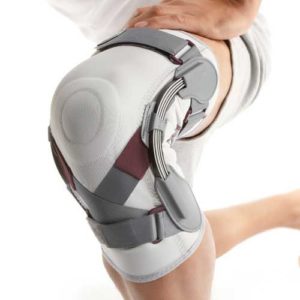
The bandage is used in situations that require rigid and secure immobilization of the knee joints. The wide grip stabilizes the knees, shins and hips, the load is distributed correctly and the joints function properly. Special corset panels are used for safety.
These are used in the same way as a plaster bandage.
A properly selected product serves not only to immobilize, but also has a massaging and thermal effect on the knee, improves blood circulation and normalizes metabolic processes in the skin and muscles.
- intra-articular fractures;
- damage to the meniscus of the knee;
- acute form of deforming arthritis;
- acute form of synovitis;
- hemarthrosis of the knee joint;
- complex traumatic ligament injuries or tears.
The orthosis is also worn after knee surgery or cast removal for partial immobilization and safe development of the joint.
The doctor prescribes the device and determines the degree of stiffening of the orthosis, taking into account the condition of the patient's knee joint.
- circulatory disorders in the leg;
- thrombophlebitis;
- Skin injuries where the orthosis is applied;
- varicose veins.
If there are contraindications, it is advisable to choose another method of fixing the injured knee joint in order to regenerate it.
types of orthotics
Some orthotic types are designed to be worn in different situations:
- a foot orthosis for the night;
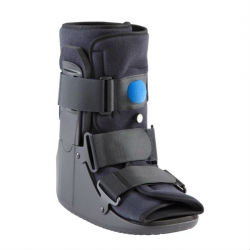
- an orthosis for children;
- For athletes during rehabilitation (recovery);
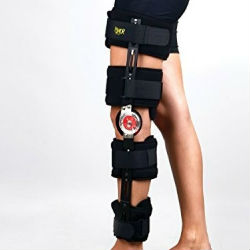
- For the knee joint;
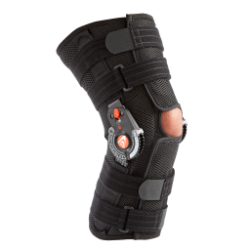
- Sports shoes for everyday use (prophylactic).
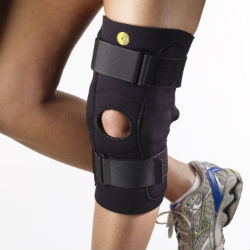
To choose the right orthotic for your foot, consult your podiatrist on which type is right for your condition and how to wear it properly.
When professional athletes should wear orthoses
In professional sports, the risk of injury is unpredictable. Therefore, the orthosis can be worn for a while as a preventive measure at the first sign of joint problems.
It is recommended to wear an orthosis during training:
Gymnastics and contact sports (martial arts) are also prone to leg injuries. Motorcycle racing and equestrian sports put a lot of strain on the feet. Beach volleyball is particularly dangerous for the ankle, as the sand is very mobile and cannot keep the foot in a stable position during the game.
For the ankle
An ankle bandage can be recommended in the following cases:
- as a recovery aid after an operation;
- in injuries of the ligamentous apparatus – tears, sprains;
- Age-related changes – arthrosis or arthritis;
- Muscular changes;
- Sport-related overloading of the joint and periarticular ligaments.
If you have a choice between wearing a cast and wearing an orthopedic brace, the latter is clearly a better choice. First, the leg is not completely immobilized, but there is acceptable play. The bandage relieves the joint. The foot is positioned at the right angle to the lower limb to ensure correct distribution of forces.
The bandage is very useful for professional athletes who have a congenital disorder of the musculoskeletal system - cerebral palsy. When this happens, nerve tissue is damaged and there is a loss of feeling in the legs or other parts of the body. Prophylactic braces help to secure the position of the legs and protect against fatigue damage.
For the knee joints
According to sports statistics, most leg injuries in athletes occur in the knee joint. If the injury is severe, bed rest and a brace are recommended after surgery.
The construction of the knee joint should be done with minimal stress and gradually. Post-traumatic knee stiffness is a common occurrence and it is the sports doctor's job to ensure that the ligaments gradually regain mobility.
How to choose the right knee brace
There are individual knee orthoses and universal orthoses. The former are recommended for severe knee injuries when a longer recovery period is required. They are made to individual measurements. The choice of orthoses recommended by the attending physician depends on the type of injury and the main purpose of the treatment. It is also advisable to choose corrective orthoses for sports knees in consultation with a specialist, especially in the case of children's orthoses.
When buying it is important to pay attention to the parameters. These may vary between similar models from different manufacturers. This is especially true if you order a knee brace from an online shop. It should always be possible to exchange or return an unsuitable brace, as trying it on may reveal a damaged or faulty attachment mechanism, which is the main part of the kneecap.

If even a small part fails or does not initially fulfill its function, the treatment makes little sense. It is also important to note the contraindications to the use of orthotics.
Orthotics are not recommended in the following cases:
- varicose veins;
- open ulcers and inflammations in the knee, lower leg and hip area;
- tumors in the area of the knee joint;
- Dermatological diseases in the acute stage;
- Individual intolerance to the product material.
Using a properly fitted bandage fastened to the leg as directed by the doctor will not cause discomfort and will not result in poor circulation and swelling. The orthosis should fully support the knee in a specific position and provide stability during movement.
cost of the orthoses
- Ortho HCH 555 – from 8,000 rubles;
- Orto Professional NKN 557 – from 8,500 rubles;
- Orliman Sport – from 2,500 rubles;
- CTi OTS – from 16,000 rubles.
Application
Orthopedic knee braces are indicated for various diseases of the lower limbs. A properly selected knee brace promotes the full recovery of the patient. It is an integral part of the comprehensive treatment and prevention of various diseases and injuries of the knee.
Read more:- What is an orthosis?.
- What are knee braces?.
- What is a knee brace?.
- orthosis.
- How to wear a knee brace for osteoarthritis.
- knee brace.
- How to properly wear a knee brace.
- Buy cheap knee orthoses.
